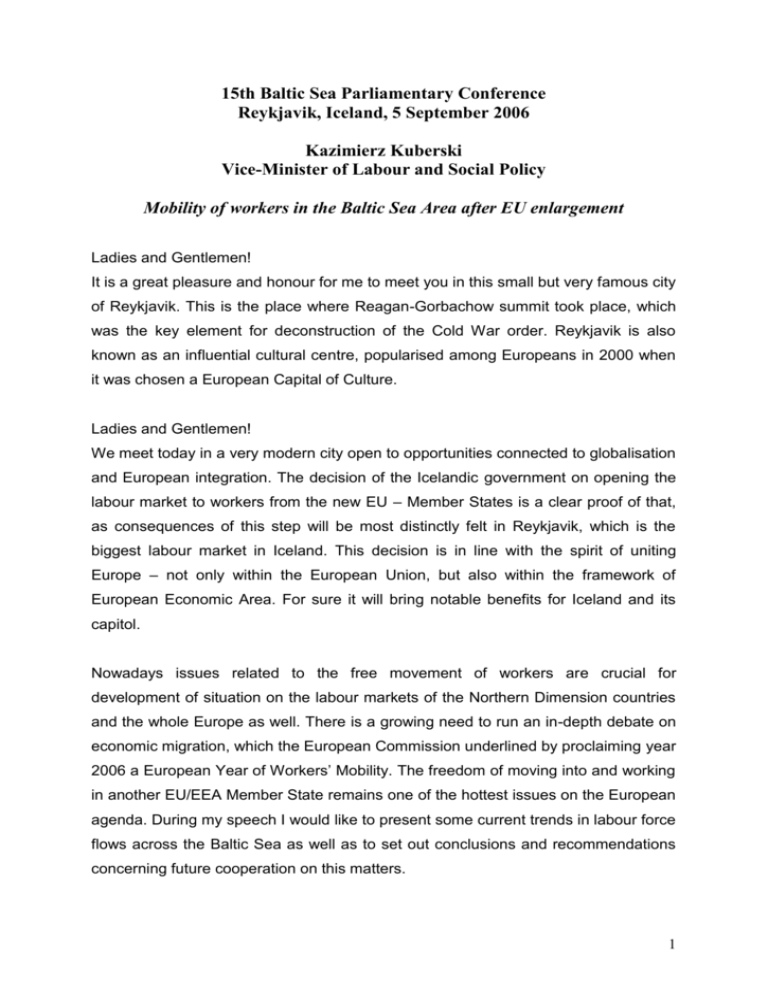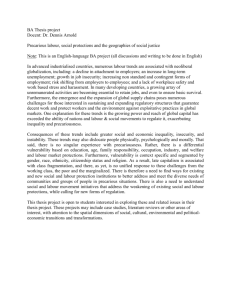Islandii, jedynego dużego miasta w kraju, założonego w 874 roku
advertisement

15th Baltic Sea Parliamentary Conference Reykjavik, Iceland, 5 September 2006 Kazimierz Kuberski Vice-Minister of Labour and Social Policy Mobility of workers in the Baltic Sea Area after EU enlargement Ladies and Gentlemen! It is a great pleasure and honour for me to meet you in this small but very famous city of Reykjavik. This is the place where Reagan-Gorbachow summit took place, which was the key element for deconstruction of the Cold War order. Reykjavik is also known as an influential cultural centre, popularised among Europeans in 2000 when it was chosen a European Capital of Culture. Ladies and Gentlemen! We meet today in a very modern city open to opportunities connected to globalisation and European integration. The decision of the Icelandic government on opening the labour market to workers from the new EU – Member States is a clear proof of that, as consequences of this step will be most distinctly felt in Reykjavik, which is the biggest labour market in Iceland. This decision is in line with the spirit of uniting Europe – not only within the European Union, but also within the framework of European Economic Area. For sure it will bring notable benefits for Iceland and its capitol. Nowadays issues related to the free movement of workers are crucial for development of situation on the labour markets of the Northern Dimension countries and the whole Europe as well. There is a growing need to run an in-depth debate on economic migration, which the European Commission underlined by proclaiming year 2006 a European Year of Workers’ Mobility. The freedom of moving into and working in another EU/EEA Member State remains one of the hottest issues on the European agenda. During my speech I would like to present some current trends in labour force flows across the Baltic Sea as well as to set out conclusions and recommendations concerning future cooperation on this matters. 1 Economic migrations across the Baltic Sea have a very long tradition reaching times when Swedish and Norwegian Vikings where settling around its shores, which among others resulted in foundation of Reykjavik settlement in A.D. 874. In 14 th and 15th century, in zenith of the Hanseatic League expansion in North and Eastern-North Europe trade flourished and high mobility of labour and services were observed. In this context, the Cold War had been only a short break in a relatively free movement of workers and services in this area. What is the migration potential of the Northern Dimension countries today? Nowadays there are around 150 billions of people living around the Baltic Sea, almost half of them being in the most mobile age group between 15 and 49 years old. 80% of population concentrates around southern shores of the Baltic Sea in Poland and Germany. These two countries are facing serious unemployment, especially Poland where at the moment it exceeds 15%. On the opposite side of scale is Iceland with the unemployment rate not bigger than 2,6% in 2005. A large gap in living conditions and wages between Eastern and Western countries of the Northern Dimension creates a system of push and pull factors making it very profitable for the area countries to send and receive workers. The Northern Dimension countries are facing today many common challenges, of which the problem of society ageing should be mentioned first. Permanent diminishment of working-age population with growing numbers of pensioners may decrease the tempo of economic growth and in consequence upset trans-generation balance and lead to inefficiency of pension system. Another big challenge is a situation where skill shortages and bottlenecks operate side by side with high unemployment. Paradoxically, this tendency is present also in countries of the East and South-East shores of the Baltic Sea where high unemployment rates suggest that labour supply is considerable. Enhanced workers mobility in the Baltic Sea area would constitute a chance to ease these problems to certain extent by balancing the present imbalance between labour supply and demand. For the new European Union Member States citizens it means access to well-paid jobs and enables them to improve skills due to gained experience and trainings. When it comes to the rest of the Member States, access to cheap and 2 effective labour force is an attractive perspective for improving competitiveness. In a word – the free movement of workers should contribute to more dynamic economic growth in the whole region. The accession of Lithuania, Latvia, Estonia and Poland opened some new perspectives for workforce mobility across the Baltic Sea. Not all of this potential was used during the first two years after the enlargement, because among the old EU Member States only Sweden had been decided to open its labour market for the citizens of the EU8 countries. What’s interesting, workers inflow to this country was few times lower than labour immigration to Norway. In 2005 Polish citizens were granted just under 3 000 residence permissions on employment or running a company basis, while in the same period of time in Norway, Poles were granted almost 24 000 work and residence permits. In the remaining Nordic countries hardly 3 500 of Poles took up employment. These figures are very low, especially comparing to the number of Poles working legally in Germany. In 2005 Poles were granted 321 757 work permits, which was possible thanks to the bilateral agreements signed on the beginning of the 90s. Governments of the EU and EEA Member States had to take a decision whether to maintain or lift transitional arrangements on the free movement of workers. In its report on functioning of this interim measures published close to the end of the first part of transitional period, the European Commission confirmed a thesis given by the new Member States during the accession negotiations – the benefits freedom of movement of workers brings with itself outnumber its challenges. Work of employees from the new EU Member States has speed up the economic growth of countries which opened their labour markets and allowed to create new jobs. They were supplementing local workers rather than replacing them, and they were not imposing pressure on the social security systems. On the other hand, in the Member States which maintained the transitional measures, a number of negative phenomena were observed, like for instance illegal employment or abuse of regulations concerning the posting of workers and the selfemployment in order to get the access to the labour markets. Particularly distressing signals were observed in Italy, where organized groups profited from illegal worker’s 3 difficult situation by exploiting them, treating them dishonestly or even violating human rights. Encouraged by positive experience of those Member States which had liberalized the access to their labour markets, Iceland and Finland opened their labour markets for workers from the new Member States, when Denmark and Norway facilitated access to theirs. For several reasons though, it shouldn’t be expected that it shall change main directions of migrations from the new Member States, which particularly concentrate on Anglo-Saxon areas. Certainly, the linguistic difficulties will be the first main obstacle for taking up employment in those countries. Particularly among Polish citizens, Nordic languages are not quite popular. What’s more important, the number of the „old” EU countries which opened their labour markets for the citizens from the new Member States has significantly increased. Besides the above mentioned Nordic countries as well as Great Britain and Ireland, the transitional measures are not applied anymore by Spain, Portugal, Greece and recently Italy. The change of the political and economic situation made these countries get rid of fears of the migrant influx and start to compete for workers from the new Member States. Actually, British, Irish and Spanish entrepreneurs actively recruit workers in Poland, searching for those with qualifications most satisfying their requirements. These enterprises are supported by the public authorities from their countries, an example of it were big job fairs organized by the Irish employment services FAS which took place in Warsaw just a few weeks ago. A competition for workers from the Central - East Europe is a new quality in the framework of the debate on worker’s migrations between the new and the old EU Member States. A new element in this debate is also more careful attitude of the public opinion towards the subject of economic migrations. Media often play a negative role here, creating sort of emigration panic. It should be emphasized though, that the decrease of enthusiasm for taking up jobs on the EU territory is somehow justified. We observe some unfavourable consequences of migrations, such as negative social effects due to family separations or loss of professional qualifications by qualified persons who took up simple jobs abroad. Another problem is lack of several categories of workers 4 reported by entrepreneurs unable to recruit properly qualified staff. Apart from the fact that, as I have already mentioned, the registered unemployment rate in Poland is around 15%, we have just finished work on legal solution which would facilitate access to the labour market for citizens of the non-EU neighbour countries who are indispensable for seasonal jobs in agriculture and animal raising sectors. Obviously that is not to say that Poland doesn’t profit from the free movement of workers. The most significant of the numerous advantages is a considerable increase of remittances which results in household wealth growth. Due to the migration opportunities, many of unemployed were activated. Abroad they acquire new skills and experience which may enhance their potentiality to find a better job after they come back to home country. Poland has a chance to repeat success of Ireland, to which, together with coming back home migrants tempted by dynamic economic growth came a stream of investments, even more stimulating for development. The mobility of the labour force between the North Dimension countries should not be hampered. We should strive to fully implement the free movement of workers by removing legal, administrative, practical and mental obstacles barriers. We also need to discuss the model migration management in the region which would ensure the effective allocation of unused labour resources in a manner profitable to sending and receiving countries. First of all, we need more effective cooperation in the field of monitoring economic migrations phenomenon, informing workers on their rights and obligations, fighting the illegal employment and fighting unfair practices applied by certain unscrupulous recruitment agencies and employers. When undertaking actions to increase the mobility of workers in the Baltic Sea area, we shouldn’t evade answering the question if societies of those countries are prepared to receive immigrants and cooperate with them. The specificity of the Nordic social model confers an important role to trade unions, for instance in determining minimal wages. Such strong workers’ organizations are also a domain of the social model in Germany. That is why the cooperation in migrations management should take into account a possibly large group of stakeholders, including national and local authorities and social partners. 5 Ladies and Gentleman, The phenomenon of the economic migrations is a compound issue, including many spheres of social life. Thus, it is difficult to present all its aspects in such a short speech. I hope though, that I have been able to present my principal idea – that the response to the challenges concerning the free movement of workers shouldn’t be given by creating artificial obstacles but by running closer cooperation between governments and other authorities dealing with mobility questions. Thus, I am glad that The Baltic Sea Parliamentary Conference gives much attention to issues related to employment, since an effective dialog is an indispensable step to find out practical solutions in this matter. Thank you very much for your attention. 6








